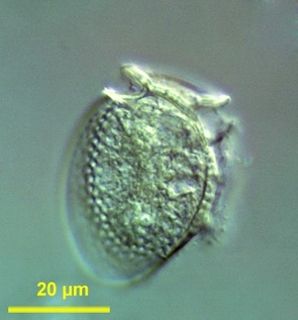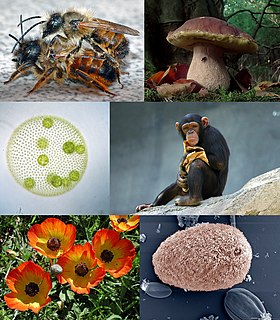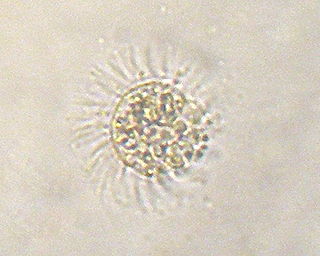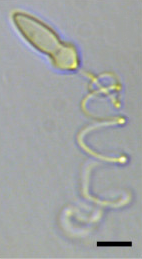Related Research Articles

Chloroplasts are organelles that conduct photosynthesis, where the photosynthetic pigment chlorophyll captures the energy from sunlight, converts it, and stores it in the energy-storage molecules ATP and NADPH while freeing oxygen from water in plant and algal cells. They then use the ATP and NADPH to make organic molecules from carbon dioxide in a process known as the Calvin cycle. Chloroplasts carry out a number of other functions, including fatty acid synthesis, much amino acid synthesis, and the immune response in plants. The number of chloroplasts per cell varies from one, in unicellular algae, up to 100 in plants like Arabidopsis and wheat.

Zooplankton are heterotrophic plankton. Plankton are organisms drifting in oceans, seas, and bodies of fresh water. The word zooplankton is derived from the Greek zoon (ζῴον), meaning "animal", and planktos (πλαγκτός), meaning "wanderer" or "drifter". Individual zooplankton are usually microscopic, but some are larger and visible to the naked eye.

Symbiogenesis, or endosymbiotic theory, is the leading evolutionary theory of the origin of eukaryotic cells from prokaryotic organisms. The theory holds that mitochondria, plastids such as chloroplasts, and possibly other organelles of eukaryotic cells are descended from formerly free-living prokaryotes taken one inside the other in endosymbiosis.

The dinoflagellates are single-celled eukaryotes constituting the phylum Dinoflagellata. Usually considered algae, dinoflagellates are mostly marine plankton, but they also are common in freshwater habitats. Their populations are distributed depending on sea surface temperature, salinity, or depth. Many dinoflagellates are known to be photosynthetic, but a large fraction of these are in fact mixotrophic, combining photosynthesis with ingestion of prey.

The alveolates are a group of protists, considered a major clade and superphylum within Eukarya, and are also called Alveolata.

The plastid is a membrane-bound organelle found in the cells of plants, algae, and some other eukaryotic organisms. They are considered endosymbiotic Cyanobacteria, related to the Gloeomargarita. The event to permanent endosymbiosis probably occurred with a cyanobiont. Plastids were discovered and named by Ernst Haeckel, but A. F. W. Schimper was the first to provide a clear definition. Plastids are the site of manufacture and storage of important chemical compounds used by the cells of autotrophic eukaryotes. They often contain pigments used in photosynthesis, and the types of pigments in a plastid determine the cell's color. They have a common evolutionary origin and possess a double-stranded DNA molecule that is circular, like that of the circular chromosome of prokaryotic cells.

Sacoglossa, commonly known as the sacoglossans or the "sap-sucking sea slugs", are a clade of small sea slugs and sea snails, marine gastropod mollusks that belong to the clade Heterobranchia. Sacoglossans live by ingesting the cellular contents of algae, hence the adjective "sap-sucking".

Kleptoplasty or kleptoplastidy is a symbiotic phenomenon whereby plastids, notably chloroplasts from algae, are sequestered by host organisms. The word is derived from Kleptes (κλέπτης) which is Greek for thief. The alga is eaten normally and partially digested, leaving the plastid intact. The plastids are maintained within the host, temporarily continuing photosynthesis and benefiting the predator. The term was coined in 1990 to describe chloroplast symbiosis.

The Archaeplastida are a major group of autotrophic eukaryotes, comprising the red algae (Rhodophyta), the green algae, and the land plants, together with a small group of freshwater unicellular algae called glaucophytes. The Archaeplastida have chloroplasts that are surrounded by two membranes, suggesting that they were acquired directly from endosymbiotic cyanobacteria. All other groups besides the amoeboid Paulinella chromatophora, have chloroplasts surrounded by three or four membranes, suggesting they were acquired secondarily from red or green algae. Unlike red and green algae, glaucophytes have never been involved in secondary endosymbiosis events.

Elysia chlorotica is a small-to-medium-sized species of green sea slug, a marine opisthobranch gastropod mollusc. This sea slug superficially resembles a nudibranch, yet it does not belong to that clade of gastropods. Instead it is a member of the clade Sacoglossa, the sap-sucking sea slugs. Some members of this group use chloroplasts from the algae they eat for photosynthesis, a phenomenon known as kleptoplasty. Elysia chlorotica is one of these "solar-powered sea slugs". It lives in a subcellular endosymbiotic relationship with chloroplasts of the marine heterokont alga Vaucheria litorea.

In cell biology, a Paraspeckle is an irregularly shaped compartment of the cell, approximately 0.2-1 μm in size, found in the nucleus' interchromatin space. First documented in HeLa cells, where there are generally 10-30 per nucleus, Paraspeckles are now known to also exist in all human primary cells, transformed cell lines and tissue sections. Their name is derived from their distribution in the nucleus; the "para" is short for parallel and the "speckle" refers to the splicing speckles to which they are always in close proximity. Their function is still not fully understood, but they are thought to regulate gene expression by sequestrating proteins or mRNAs with inverted repeats in their 3′ UTRs.

Plant evolution is the subset of evolutionary phenomena that concern plants. Evolutionary phenomena are characteristics of populations that are described by averages, medians, distributions, and other statistical methods. This distinguishes plant evolution from plant development, a branch of developmental biology which concerns the changes that individuals go through in their lives. The study of plant evolution attempts to explain how the present diversity of plants arose over geologic time. It includes the study of genetic change and the consequent variation that often results in speciation, one of the most important types of radiation into taxonomic groups called clades. A description of radiation is called a phylogeny and is often represented by type of diagram called a phylogenetic tree.
The CoRR hypothesis states that the location of genetic information in cytoplasmic organelles permits regulation of its expression by the reduction-oxidation ("redox") state of its gene products.

Dinophysis is a genus of dinoflagellates common in tropical, temperate, coastal and oceanic waters. It was first described in 1839 by Christian Gottfried Ehrenberg.

Eukaryotes are organisms whose cells have a nucleus enclosed within a nuclear envelope. Eukaryotes belong to the domain Eukaryota or Eukarya; their name comes from the Greek εὖ and κάρυον. The domain Eukaryota makes up one of the domains of life in the three-domain system; the two other domains are Bacteria and Archaea. Eukaryotes represent a tiny minority of the number of living organisms; however, due to their generally much larger size, their collective worldwide biomass is estimated to be about equal to that of prokaryotes. Eukaryotes evolved approximately 1.6–2.1 billion years ago, during the Proterozoic eon.
Mesodinium chamaeleon is a ciliate of the genus Mesodinium. It is known for being able to consume and maintain algae endosymbiotically for days before digesting the algae. It has the ability to eat red and green algae, and afterwards using the chlorophyll granules from the algae to generate energy, turning itself from being a heterotroph into an autotroph. The species was discovered in January 2012 outside the coast of Nivå, Denmark by professor Øjvind Moestrup.

Dinophysis acuminata is a marine plankton species of dinoflagellates that is found in coastal waters of the north Atlantic and Pacific oceans. The genus Dinophysis includes both phototrophic and heterotrophic species. D. acuminata is one of several phototrophic species of Dinophysis classed as toxic, as they produce okadaic acid which can cause diarrhetic shellfish poisoning (DSP). Okadiac acid is taken up by shellfish and has been found in the soft tissue of mussels and the liver of flounder species. When contaminated animals are consumed, they cause severe diarrhoea. D. acuminata blooms are constant threat to and indication of diarrhoeatic shellfish poisoning outbreaks.

Mesodinium rubrum is a species of ciliates. It constitutes a plankton community and is found throughout the year, most abundantly in spring and fall, in coastal areas. Although discovered in 1908, its scientific importance came into light in the late 1960s when it attracted scientists by the recurrent red colouration it caused by forming massive blooms, that cause red tides in the oceans.

Polykrikos is one of the genera of family Polykrikaceae that includes athecate pseudocolony-forming dinoflagellates. Polykrikos are characterized by a sophisticated ballistic apparatus, named the nematocyst-taeniocyst complex, which allows species to prey on a variety of organisms. Polykrikos have been found to regulate algal blooms as they feed on toxic dinoflagellates. However, there is also some data available on Polykrikos being toxic to fish.

Mesodinium is a genus of ciliates that are widely distributed and are abundant in marine and brackish waters. Currently, six marine species of Mesodinium have been described and grouped by nutritional mode: plastidic or heterotrophic. There is some debate as to whether the nutritional mode of plastidic Mesodinium species is phototrophic or mixotrophic. Among the plastidic species, wild M. major and M. rubrum populations possess red plastids belonging to genera Teleaulax, Plagioselmis, and Geminigera, while wild M. chamaeleon and M. coatsi populations normally contain green plastids. The availability of suitable cryptophyte prey is important for bloom formation of plastidic Mesodinium species.
References
- 1 2 3 Johnson, Matthew D.; Oldach, David; et al. (25 January 2007). "Retention of transcriptionally active cryptophyte nuclei by the ciliate Myrionecta rubra". Nature . Nature Publishing Group. 445 (7126): 426–428. Bibcode:2007Natur.445..426J. doi:10.1038/nature05496. PMID 17251979. S2CID 4410812 . Retrieved 4 February 2015.